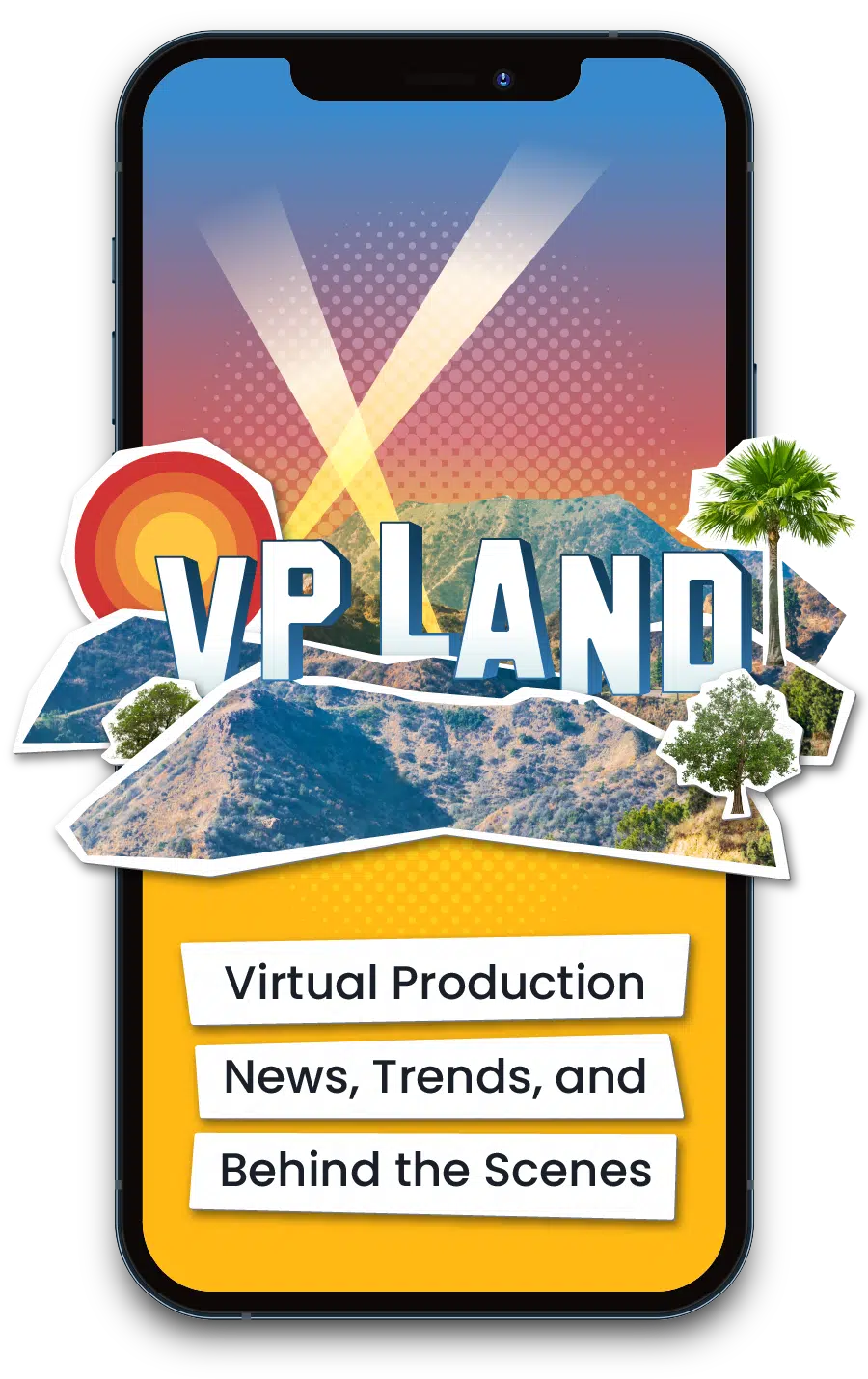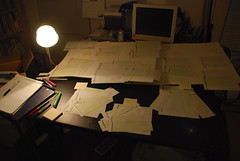 I have five hours of footage (300 minutes) spanning seven tapes that I must now whittle down into one amazing seven minute documentary. It’s definitely intimidating. I think it’s worse than trying to find a needle in a haystack because I don’t care if I don’t find the needle and no one’s going to criticize the needle.
I have five hours of footage (300 minutes) spanning seven tapes that I must now whittle down into one amazing seven minute documentary. It’s definitely intimidating. I think it’s worse than trying to find a needle in a haystack because I don’t care if I don’t find the needle and no one’s going to criticize the needle.
So how do I get a hold of what my footage contains and how I tell my documentary? One way is to import two hours of footage onto the computer (two hours is the limit so we don’t max out the hard drives), go through all the clips, drag and drop them on the time-line, move things around, experiment, get a few rough cuts, get some feedback, and hopefully be able to pull a great film together…in two weeks.
I’ve tried this before with less footage and it’s very easy to get lost because there’s no easy way to sit back and scan everything. Instead, I’m trying a new way, one that was mentioned in class and presented in Directing the Documentary (highly recommended). It’s called the Paper Edit.
Below is the process I went/am going through:
- Transcribe all your footage. Yes, this is not the most exciting of tasks, but with previously mentioned InqScribe it doesn’t have to be so bad. We were only required to transcribe the two hours we were going to import, but I didn’t know what it was I wanted to import until I knew what I had. Transcribing forces you to watch and listen to every single word. I’ve seen every second of my footage, listened to it, and written it down. Somewhere deep in my subconscious I’ve got a mental log of everything that I’ve shot. If you just watch your footage and take some notes it’s too easy to pass over material or zone out. It takes a bit of time, but transcribe everything (and insert time-codes as often as possible for easy reference).
- Print your transcripts. Now that you’ve put in all the hours transcribing, it’s time to make your work tangible by printing it out. Holding a freshly printed stack of paper makes all the time and effort worth it. Directing the Documentary says to file this copy away and make another copy, but since we life in the digital world there’s no need to kill any more trees.
- Get some coffee.
- Watch your footage again, with transcripts in one hand and highlighter in the other.
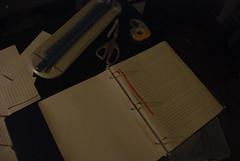 Some second-years I talked to said they transcribed their footage, but it didn’t really help them because what was said and how it was said are two drastically different things. I remember hearing that when we communicate with each other (and this is from memory with no sources to cite), 70% is in body language, 20% is how we say it, and only 10% is what we say.So yes, just reading your transcripts and highlighting good parts is not going to work. Unlike a written paper, you can’t grab a good one liner buried in crap and add ellipses to it. You need good size clips that are audible and visually interesting, and the only way to do that is re-watch the footage with your transcripts, and then highlight (with a dark color – not yellow) the good parts after visually confirming that they’re good. I even went so far as to double highlight sections that were golden-good.
Some second-years I talked to said they transcribed their footage, but it didn’t really help them because what was said and how it was said are two drastically different things. I remember hearing that when we communicate with each other (and this is from memory with no sources to cite), 70% is in body language, 20% is how we say it, and only 10% is what we say.So yes, just reading your transcripts and highlighting good parts is not going to work. Unlike a written paper, you can’t grab a good one liner buried in crap and add ellipses to it. You need good size clips that are audible and visually interesting, and the only way to do that is re-watch the footage with your transcripts, and then highlight (with a dark color – not yellow) the good parts after visually confirming that they’re good. I even went so far as to double highlight sections that were golden-good. - Copy the highlighted transcripts. Sorry trees, but we need to copy everything again. This is why you need to use a dark highlighter – yellow is too hard to see.
- Cut out all the highlighted sections. It’s arts and crafts time. Go through all the footage and cut out all the chunks you highlighted (make sure each section is labeled with the tape number as well) and recycle the scraps. It helps to do this at a big table, because you’ll need the space (learned this the hard way).
- Stare at the sprawled out pile of paper, and know that somewhere in this mess is one amazing film (hopefully).
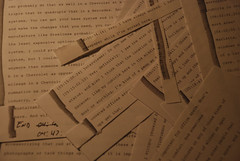 You just have to find the right order. One happy effect I found at this point in the process was the ability to mix things up.One of the downsides of watching the footage many times, in the order in which it was shot, is I started to connect each clip chronologically. It became hard to separate the locations and see different possibilities with other clips from other interviews, which is what editing is all about.So by spreading out all of my cut up paragraphs without much reference as to who said what, I could randomly pick out a piece and just see the information for what it is.
You just have to find the right order. One happy effect I found at this point in the process was the ability to mix things up.One of the downsides of watching the footage many times, in the order in which it was shot, is I started to connect each clip chronologically. It became hard to separate the locations and see different possibilities with other clips from other interviews, which is what editing is all about.So by spreading out all of my cut up paragraphs without much reference as to who said what, I could randomly pick out a piece and just see the information for what it is. - Make a paper edit of your film. I know that’s kind of fuzzy, but that’s where I’m at right now. Here’s something a little more concrete: organize the paragraphs into categories, whether it’s ideas, locations…anything that will let you group different pieces together so they can be edited together.
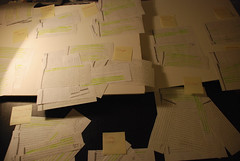 I’m not sure if this is going to work, it’s just the direction I’ve decided to take. I picked up every piece of paper, re-highlighted the really golden-good stuff that still sticks out to me, and grouped it into a category. Here are some category examples: Interviewee Introductions, Cubicle Opinions, Personalization, Design, Thought, Productivity, Psychology, Future.
I’m not sure if this is going to work, it’s just the direction I’ve decided to take. I picked up every piece of paper, re-highlighted the really golden-good stuff that still sticks out to me, and grouped it into a category. Here are some category examples: Interviewee Introductions, Cubicle Opinions, Personalization, Design, Thought, Productivity, Psychology, Future.
If I had more time I’d go through each category, cut out the golden-good stuff and start pasting it on some paper to make a sequence. In theory I’d have a rough cut of the film before I even started editing. But I have to start importing today so that’s not going to happen.
I don’t think by not having a completed paper edit all this time and effort was wasted. Like I said, deep down in my mind I know every piece of footage that I have.
I’ve also found this process to be like an inverted pyramid. By laying out all the transcripts I can instantly get a glance of everything that I have. Then I just narrow it down, more and more with each edit, until it becomes a well composed seven minute documentary that will hopefully exist in two weeks. I’m going to need a lot of coffee.

